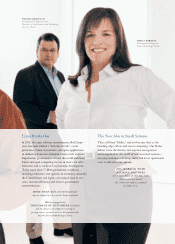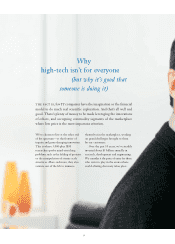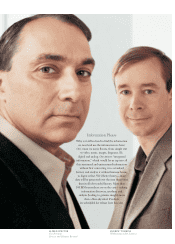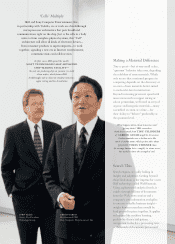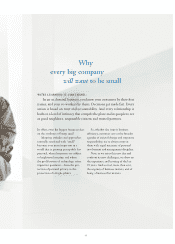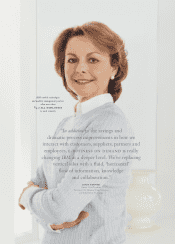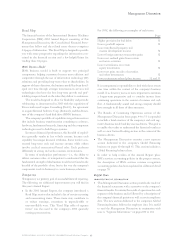IBM 2002 Annual Report Download - page 35
Download and view the complete annual report
Please find page 35 of the 2002 IBM annual report below. You can navigate through the pages in the report by either clicking on the pages listed below, or by using the keyword search tool below to find specific information within the annual report.
Making a Material Difference
Tiny is great—but at very small scales,
“quantum” behavior takes over, degrading
the reliability of some materials. Which
only means that continued progress in
computing depends on the discovery or
creation of new materials better suited
to molecular-level construction.
Beyond increasing processor speed with
innovations such as copper wiring or
silicon germanium, we’ll need an array of
organic and inorganic materials—many
assembled an atom at a time—for
their ability to “behave” predictably at
the quantum level.
What happens when silicon transistors can’t
get any tinier? IBM researchers
think devices made from tiny cylinders
of carbon atoms might be the answer.
Carbon nanotubes are a chicken-wire-like
mesh of carbon atoms rolled up into tubes about
50,000 times thinner than
the average human hair—roughly 10 atoms across,
but with five times the strength of steel.
Search This
Search engines are sadly lacking in
insight and judgment. Getting beyond
those limitations is the impetus for a new
IBM technology called WebFountain.
Using sophisticated analytical tools, it
combs through billions of documents
from the Web, news sources and a
company’s own information stockpiles
to uncover valuable business insight
—
insight human researchers would be
hard pressed to piece together. It applies
techniques like machine learning,
probability theory and pattern
recognition to the data, processing tens
of thousands of documents per second.
‘Cells’ Multiply
IBM and Sony Computer Entertainment, Inc.,
in partnership with Toshiba, are at work on a breakthrough
microprocessor architecture that puts broadband
communications right on the chip. Just as the cells in a body
unite to form complete physical systems, this “Cell”
architecture will allow all kinds of electronic devices
—
from consumer products to supercomputers
—
to work
together, signaling a new era in Internet entertainment,
communications and collaboration.
In July 2002, IBM opened the world’s
most technologically advanced
chip-making facility—
the only one producing chips on 300mm (12-inch)
silicon wafers, which feature IBM
breakthroughs such as silicon-on-insulator transistors,
copper wiring and low-k insulation
ken kutaragi
President and CEO
Sony Computer Entertainment, Inc.
john kelly
Senior Vice President
Technology Group
33








